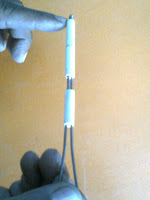 |
| Furnace Heated by Resistance wire |
Now a days an electric furnace is taking major role both for domestic and Industrial application. A chamber heated by electric current is known as Electric Furnace.There are many types of furnaces, also named as per purpose of use. Heat treatment furnace, Pit type furnace, Combustion furnace, Induction furnace, Muffle furnace etc. Electric furnaces are more cheaper than oil fired furnaces and gas fired furnace.To make an Electric furnace refractory bricks, heating elements, compensating cables, thermocouples, temperature Indicator-cum-controller etc. required.
 |
| Insulation Bricks |
Best quality refractory bricks must be used in the furnaces either for coil holding or for insulation purpose, now a days, also ceramic bricks or ceramic blankets are used for insulation and this is also found to be the best insulation material for furnace. However, we should not forget that best insulation increase the life of any furnace. Resistance temperature of insulation material should be more than working temperature of furnace.
There are many type of heating element, we are discussing here about some common elements used in small size furnaces. Main function of heating elements to convert electricity to heat. Nichrome 80/20 and also Kanthal A'1 found the best heating elements within continuous working temperature of 1050 to 1100deg.c. available both strip, ribbon and also wire form. Another heating element is Silicon Carbide heating elements. Silicon Carbide heating elements is also a best heating element. Silicon Carbide works continuously at a high temperature up to 1450deg.c. & no support require to hold this heating element.
 |
| Resistance Heating Elements |
- Common maximum Temperature of heating Elements :
- Kanthal A1 - max 1400degc.
- Kanthal AF - max 1300degc.
- Silicon Carbide - max range between 1300 from 1500deg.
Thermocouples :
Thermocouples are pairs of dissimilar material wired and Joined at least one end. Function of any thermocouple wire is to convert heat or cool to Milli volt. In 1821, the German-Estonian Physicist John Allen seebeck discovered that when any conductor such as metal is subjected to a thermal gradient, it will generate a Voltage.
 |
| Thermocouple |
Its also a very important that the right compensating cable is used between the controller and the thermocouple probe. Every different type of thermocouple has its own compensating cables. Compensating cable use the actual thermocouple materials but in cheaper forms.When connecting a thermocouple to Temperature controller through compensating cable most important to know what is positive and what is negative wire of compensating cable. Don't take for granted that RED is always positive and WHITE is negative. All cable have colour cord which are depending on the country of manufacturing.
 |
| Compensating Cables |
- Continuous working Temperature range for most common use Thermocouples:-
- Type- K - (Cromel-Alumel) Temperature range 0 to +1200deg.c. {general Purpose T/c}
- Type- J -Temperature range 0 to +750deg.c.
- Type- R - Pt/Pt-Rh13% Temperature range 0 to +1600deg.c.
- Type- B - Used Platinum and Rhodium contain each conductor one 30% rhodium and another 6% rhodium +200 to 1700deg.c.
- Type - S - Suitable for higher temperature range between 0 to +1600deg.c.
- Type- T - Copper & Constantant, both conductors are non-magnetic (-)185 to +300deg.c.
- Type- E - Cromel & Constantan both conductors are non-magnetic 0 to +800deg.c.
- Another one is RTDs ( resistance temperature detectors) used in widely Industrial sector for its more accuracy within its range (-)200 to +500deg.c.
To control the temperature of any furnace a temperature controller is inevitable. It may be a blind temperature controller or Digital Temperature indicator-cum-controller. Temperature controller are available in market many types. So one has to choose a best temperature controller as per requirement of furnace. Function of On & off type temperature controller commonly used in furnace to control mood of furnace to on and off as per set temperature and it will continue up to switch off the furnace.
Proportional Temperature Controller and PID temperature controller. PID temperature controller known as P= Proportional, I= Integral, D= Derivative., PID calculate process variable & desired set point to minimize the error by adjusting process control input. For operating of PID some little technical knowledge is require.
 |
| Temperature Controllers |